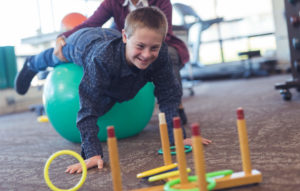What is Occupational Therapy? Part Two – 5 Through 18 Years
 Last week, in Part 1 of “What is Occupational Therapy?”, I spoke about what OTs look at for in the age range of birth to 4 years. I will now discuss ages 5-18 years. Remember, I am looking at the overall development levels of the child. I need to know this information in order to help families and children reach the ultimate goal of OT treatment. The ultimate goal is to support a child’s ability to participate in their daily living activities.
Last week, in Part 1 of “What is Occupational Therapy?”, I spoke about what OTs look at for in the age range of birth to 4 years. I will now discuss ages 5-18 years. Remember, I am looking at the overall development levels of the child. I need to know this information in order to help families and children reach the ultimate goal of OT treatment. The ultimate goal is to support a child’s ability to participate in their daily living activities.
What is Occupational Therapy Assessing?
I begin by assessing cognitive, sensory, motor, and social-emotional skills. I am going to give a brief explanation of each followed by specifics for specific age ranges.
Cognitive
How is the child developing cognitively? This includes looking at basic arousal and attention skills as well as what is labeled as executive function skills.
Sensory
How does the child respond to the sensations they receive on a daily basis? This includes how they take in sounds, sights, smells, tastes, touch, and movement to interpret and respond.
Motor
How is the child moving? What skills do they have? This includes the basics of strength, mobility, balance, and coordination. I am also looking at how they plan and execute movement as a whole.
Social-Emotional
How is the child developing their abilities to understand themselves, their emotions, and how they interact with others?
Occupational Therapy for School Age (5 to 12 Years)
Firstly, I am looking to see how developmental skills from early childhood are carrying over and how the child participates in school demands. I am now looking at motor and cognitive skills needed to participate in structured learning. Is motor planning supporting more organized play, sports involvement, and daily living? Are a child’s social-emotional skills growing so they can now manage themselves in the family and in learning environments? This is where OTs are also called in to look more closely at fine motor skills and visual skills. It is also a time where we hear more about executive function skills. This age range is where these skills become more noticeable by parents and teachers. Now I am looking to see if problem-solving, time management, organization skills, etc., are growing?
I also continue to look at participation in routines and how independent a child is becoming. Can a child manage their self-care, feeding, and toileting? Some OTs will specialize in feeding (mealtime routines, behavior, self-feeding), toileting (potty training routines, bladder/bowel control), primitive reflexes, visual development (more specific when visual problems are present), sleep, sensory processing, mental health, social skill training, and learning challenges or disabilities.
Occupational Therapy for School Age/Adolescents (13-18 Years)
OTs continue to support all areas of development. In addition, in this age range, I am looking at how to continue supporting growth. Involvement in school; academics and social participation. Are executive functioning skills supporting higher levels of independence? Have motor skills continued to grow? Some OTs will specialize in mental health, social skill training, learning challenges or disabilities, driving, and vocational/job training.
Finally, the key to what makes OTs experts in their area is their ability to take all of this information and develop a treatment plan that will improve a child’s overall participation in daily activities. Of course, these activities vary with every child and family. Hopefully the information provided here can help better explain what an OT is thinking about when working with your child. For more information, check out the American Occupational Therapy Association’s What is OT? brochure.
